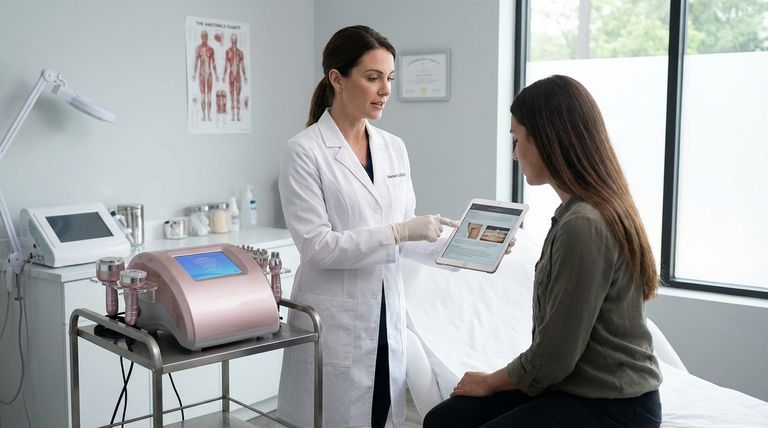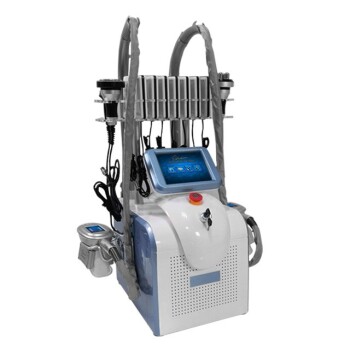Ultrasonic cavitation is not a universally suitable procedure and is strictly contraindicated for specific groups. The most critical exclusions are pregnant and breastfeeding women and any individual with a skinfold of less than 2 cm in the targeted treatment area.
The core principle is one of safety and efficacy: the procedure is designed for localized body contouring, not overall weight loss, and its safety depends on a healthy metabolic system and a sufficient layer of fat to treat without affecting underlying organs.

Who is an Ideal Candidate? Understanding the Purpose
To understand who cannot get ultrasonic cavitation, it's essential to first define the ideal candidate. The treatment is not a tool for significant weight loss but rather for fine-tuning body contours.
The Importance of a Stable BMI
The procedure is most effective for individuals who are at or near their ideal body weight. A steady Body Mass Index (BMI) within the healthy range (approximately 18.5 to 24.9) is a common guideline.
This indicates that the person has stable lifestyle habits and is seeking to address specific, stubborn pockets of fat that are resistant to diet and exercise, such as on the abdomen.
Sufficient Localized Fat
A critical safety requirement is the presence of enough adipose (fat) tissue. The standard measure is a skinfold of at least 2 cm.
This ensures there is a thick enough layer for the ultrasonic waves to target the fat cells exclusively, without posing any risk to the underlying organs or tissues.
Critical Contraindications: Who Must Avoid This Treatment?
Certain conditions make ultrasonic cavitation unsafe or inappropriate. A consultation with a qualified provider is non-negotiable to assess your specific health profile.
During Pregnancy and Breastfeeding
This is an absolute contraindication. The effects of the ultrasonic waves and the subsequent release of triglycerides into the bloodstream on a developing fetus or a nursing infant are unknown.
To ensure the safety of both mother and child, this procedure must be avoided entirely during these periods.
Insufficient Adipose Tissue
As mentioned, if the skinfold in the target area is less than 2 cm, the treatment cannot be performed safely. There is not enough of a buffer between the skin and the internal organs.
Attempting to treat an area with insufficient fat could lead to the ultrasonic energy penetrating deeper than intended, which is a significant risk.
The Role of Your Metabolic System
Ultrasonic cavitation works by breaking down fat cells. The contents of these cells—triglycerides—are released and must be processed and eliminated by the body's lymphatic and metabolic systems.
This means that individuals with compromised liver or kidney function are not suitable candidates. A healthy system is required to safely and effectively clear the released fat from the body.
Making a Safe and Informed Decision
Understanding these parameters is key to having a safe and effective treatment. Always approach this or any cosmetic procedure with a clear understanding of its purpose and limitations.
- If your primary focus is targeting stubborn pockets of fat with a stable weight: You may be a good candidate, provided you meet all safety and health criteria.
- If your primary focus is significant weight loss: This procedure is not the appropriate tool; focus on foundational health principles like diet and exercise first.
- If you are pregnant, breastfeeding, or have underlying health concerns: You must avoid this procedure and speak with a doctor to determine the safest path toward your goals.
Ultimately, a thorough consultation with a qualified and certified professional is the only way to determine if this procedure is truly right for your specific health profile.
Summary Table:
| Contraindication | Reason for Exclusion |
|---|---|
| Pregnant/Breastfeeding | Unknown effects on fetus/infant; safety precaution. |
| Skinfold < 2 cm | Risk of energy penetrating to underlying organs. |
| Liver/Kidney Issues | Compromised ability to process released fat byproducts. |
| Significant Weight Loss Goal | Designed for contouring, not major weight reduction. |
Ensure a safe and effective treatment with professional-grade equipment from BELIS.
BELIS specializes in professional medical aesthetic equipment, serving medical aesthetics clinics and premium beauty salons. Our advanced ultrasonic cavitation machines are engineered with precision and safety protocols to support your practice in delivering optimal, reliable results for suitable candidates.
Contact BELIS today to learn how our equipment can enhance your service offerings and ensure client safety.
Visual Guide

Related Products
- Ultrasonic Cavitation Radiofrecuency Machine for Body Slimming
- EMSlim Body Sculpting Machine EMS Body Slimming Machine
- Cryolipolysis Fat Freezing Machine Ultrasonic Cavitation Fat Reducing Device
- EMSlim RG Laser Body Sculpting and Slimming Machine
- EMS Body Sculpting Machine for Body Slimming and Sculpting
People Also Ask
- How many RF sessions do you need to see results? Achieve firmer, tighter skin with a personalized plan.
- Do fat cavitation machines really work? A Professional's Guide to Body Sculpting
- What are the negative side effects of cavitation? Understanding the Risks for Your Practice
- What does a cavitation machine do for your body? Sculpt Your Contours Without Surgery
- Does cavitation destroy fat cells permanently? Yes, for targeted, stubborn fat reduction.



















